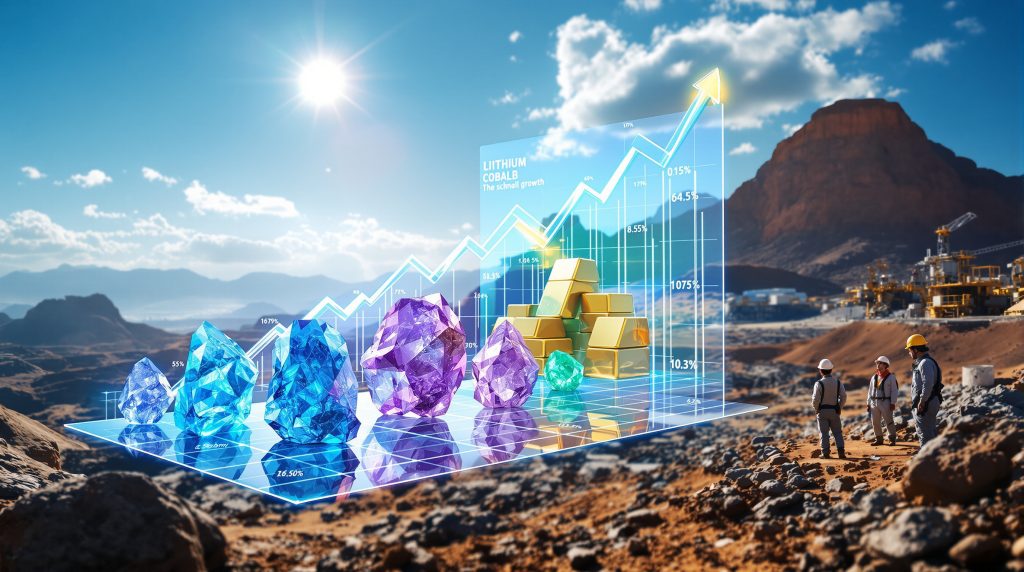Prioritisation of High Potential Minerals: Strategic Approaches for Economic Growth
In today's rapidly evolving global economy, countries worldwide are increasingly recognizing the strategic importance of identifying and developing their mineral resources effectively. The prioritisation of high potential minerals has emerged as a critical economic strategy that can drive sustainable development, enhance industrial capabilities, and secure vital supply chains.
What Are High Potential Minerals and Why Do They Matter?
High potential minerals represent resources with significant economic value and strategic importance for industrial development and technological advancement. These minerals form the backbone of modern economies, serving as essential inputs for manufacturing, renewable energy technologies, electronics, defense systems, and countless other applications.
The strategic importance of these minerals has grown substantially in recent years due to several factors:
- Accelerating technological innovation requiring specialized mineral inputs
- Growing competition for limited resources among major economies
- Increasing concerns about supply chain security and resilience
- Rising demand for minerals essential to the critical minerals energy transition
- Strategic economic advantages gained through domestic processing and value addition
For resource-rich countries, the effective prioritisation of high-value minerals can create substantial economic benefits. These include increased export revenues, job creation, industrial development, and technological advancement. The economic multiplier effects from strategic mineral development often extend far beyond the mining sector itself.
However, realizing these benefits requires a systematic approach to mineral prioritisation that balances economic objectives with environmental sustainability, community interests, and long-term national development goals.
How Are Countries Identifying High Potential Minerals?
Assessment Methodologies
Countries are employing increasingly sophisticated methodologies to identify and prioritize minerals with the highest economic potential:
- Economic Impact Analysis: Evaluating minerals based on their contribution to GDP, employment generation, and export potential
- Supply Risk Assessment: Analyzing geopolitical factors, concentration of production, and substitution possibilities
- Industrial Application Mapping: Identifying minerals essential for strategic industries and emerging technologies
- Resource Availability Studies: Assessing domestic reserves and production capabilities against global demand
- Value Chain Analysis: Determining opportunities for domestic processing and manufacturing
- Market Trend Forecasting: Projecting future demand based on technological and industrial developments
These assessment frameworks help countries move beyond traditional approaches that focused primarily on resource abundance or historical production patterns. Modern mineral prioritisation strategies take a more holistic view, considering the entire value chain from extraction to end-use applications.
Case Study: South Africa's Mineral Prioritisation Framework
South Africa offers an instructive example of mineral prioritisation in action. The country has implemented a comprehensive framework through the Mineral Resources Development Bill (MRDB) of 2025, which identifies minerals based on:
- Economic growth potential
- Industrial development contribution
- Employment generation capacity
- Export earnings potential
- Strategic importance for emerging technologies
This approach represents a significant shift in how South Africa mineral beneficiation manages its mineral resources. Rather than treating all minerals equally, the MRDB creates a tiered system that directs policy support, investment incentives, and regulatory attention to minerals with the highest potential for economic impact.
Early results from this approach have been promising. According to recent economic data, South Africa's mining production increased by 4.4% year-on-year in July 2025, with particularly strong performance in iron ore (12.2% increase) and platinum group metals (6.2% increase). These positive developments have contributed to broader economic growth, with the mining sector expanding by 3.7% in Q2 2025.
Which Minerals Are Being Prioritized Globally?
Critical Minerals for Energy Transition
The global energy transition has dramatically reshaped mineral prioritisation strategies worldwide. Several minerals have emerged as particularly critical for renewable energy technologies, energy storage, and electrification:
- Lithium: Essential for battery technologies and energy storage systems
- Cobalt: A key component in high-performance batteries, particularly for electric vehicles
- Rare Earth Elements: Crucial for permanent magnets used in wind turbines and electric motors
- Graphite: Required for battery anodes and various industrial applications
- Nickel: Important for batteries and stainless steel production
The strategic importance of these minerals is reflected in their rapid demand growth and increasingly concentrated supply chains. For example, lithium demand is projected to increase by more than 40% by 2030, driven primarily by battery applications.
Industrial and Technology Minerals
Beyond energy transition minerals, countries are also prioritizing resources essential for advanced manufacturing and technological development:
- Copper: The foundation of electrical infrastructure and renewable energy systems
- Platinum Group Metals: Critical for catalytic converters, fuel cells, and emerging green technologies
- Manganese: Essential for steel production and increasingly important for battery technologies
- Vanadium: Valuable for energy storage systems and high-strength steel alloys
- Silicon: Fundamental to the semiconductor industry and solar panel production
These minerals support diverse industrial applications and often serve as enabling resources for multiple economic sectors. Their prioritisation reflects growing recognition of the strategic advantages gained through domestic processing and manufacturing capabilities.
What Legislative Frameworks Support Mineral Prioritisation?
Key Legislative Developments
Effective mineral prioritisation requires robust legislative frameworks that balance economic development with sustainability concerns:
- Resource Classification Systems: Frameworks that categorize minerals based on economic importance and supply risk
- Strategic Mineral Acts: Legislation that provides incentives for exploration and development of priority minerals
- Supply Chain Security Measures: Regulations that promote domestic processing and manufacturing
- Environmental Safeguards: Provisions that ensure sustainable extraction and processing methods
- Community Benefit Mechanisms: Requirements for local economic development and benefit sharing
These legislative tools help create the enabling environment necessary for strategic mineral development. They provide regulatory certainty for investors, establish clear priorities for government agencies, and ensure that mineral development contributes to broader societal goals.
South Africa's MRDB Implementation
The implementation of South Africa's Mineral Resources Development Bill (MRDB) in 2025 represents a significant advancement in mineral prioritisation legislation. According to mining industry analysis, the full implementation of the MRDB "will further shape industry practices and standards, leading to industry consolidation as sustainable practices become standardised."
The bill establishes:
- Clear criteria for identifying high potential minerals
- Streamlined permitting processes for priority projects
- Fiscal incentives for investment in strategic mineral development
- Requirements for domestic processing and value-addition
- Mechanisms to address historical inequities in resource access
This comprehensive approach recognizes that effective mineral prioritisation requires more than just identifying important resources—it also necessitates creating the right conditions for responsible development and value maximization.
How Does Mineral Prioritisation Drive Economic Growth?
Economic Impact Metrics
Strategic mineral prioritisation can generate substantial economic benefits across multiple dimensions:
- GDP Growth: Mineral development creates direct economic value through extraction and processing
- Employment Generation: Mining operations create jobs at various skill levels, from operational to technical and managerial
- Export Revenues: Mineral exports generate foreign exchange earnings and improve trade balances
- Tax Contributions: Mining operations provide tax revenues for public services and infrastructure
- Industrial Development: Domestic processing creates higher-value products and supports manufacturing sectors
Recent economic data from South Africa illustrates these impacts. The country's economy grew by 0.8% in Q2 2025, up from 0.1% in Q1, with mining playing a significant role in this improvement. The mining sector itself expanded by 3.7% during this period, demonstrating its potential as an economic growth engine.
South Africa's Economic Recovery Through Mining
South Africa's experience highlights how strategic mineral prioritisation can contribute to broader economic recovery. After a decade of muted economic performance, with GDP increasing by an average of only 0.7% over the ten-year period, the recent mining sector revival offers hope for a more sustainable growth trajectory.
Industry analysts note that this pattern "signals a robust recovery in mining, which is a historically significant economic sector we all need to continue to play a vital role in the country's economic landscape." The mining industry's contribution extends beyond direct production to include manufacturing linkages, with the manufacturing sector growing by 1.8% in Q2 2025, partially driven by mineral processing activities.
What Are the Challenges in Implementing Mineral Prioritisation Strategies?
Implementation Barriers
Despite the potential benefits, countries face several challenges in effectively prioritizing high potential minerals:
- Investment Attraction: Securing sufficient capital for exploration and development
- Infrastructure Limitations: Addressing transportation, energy, and water requirements
- Technical Capacity: Developing skilled workforce and technological capabilities
- Market Volatility: Managing price fluctuations and demand uncertainty
- Environmental Concerns: Balancing extraction with sustainability objectives
- Social License: Ensuring community support and equitable benefit sharing
- Governance Issues: Combating corruption and ensuring transparent resource management
These challenges are particularly acute in developing economies, where infrastructure deficits, capacity limitations, and governance issues may hinder effective implementation of mineral prioritisation strategies.
Stakeholder Perspectives
Successful mineral prioritisation requires alignment among diverse stakeholders, each with different priorities and concerns:
- Government Agencies: Need for coordinated policy approaches across departments
- Mining Companies: Seeking regulatory certainty and investment incentives
- Communities: Demanding equitable benefit sharing and environmental protection
- Investors: Requiring clear frameworks for risk assessment and return evaluation
- Downstream Industries: Seeking reliable supply chains for manufacturing inputs
- Civil Society Organizations: Advocating for environmental protection and community rights
Balancing these sometimes competing interests requires inclusive governance mechanisms, transparent decision-making processes, and genuine commitment to sustainable development principles.
How Can Countries Optimize Their Mineral Prioritisation Approaches?
Best Practices for Strategic Implementation
Based on global experience, several best practices have emerged for effective mineral prioritisation:
- Data-Driven Decision Making: Using comprehensive geological surveys and market analyses to inform prioritisation decisions
- Public-Private Partnerships: Leveraging complementary capabilities of government and industry
- Value Chain Integration: Promoting domestic processing and manufacturing to maximize economic benefits
- Skills Development: Investing in technical education and workforce training to support the mining sector
- Sustainable Practices: Implementing environmentally responsible extraction and processing methods
- Community Engagement: Ensuring local benefits and maintaining social license to operate
- Adaptive Management: Regularly reviewing and updating prioritisation frameworks to reflect changing market conditions
These practices help countries move beyond simple resource extraction to develop integrated mineral strategies that create lasting economic value.
Innovation and Technology Integration
Technological advancements are enhancing mineral prioritisation effectiveness in several ways:
- Advanced Exploration Techniques: Improving discovery rates and reducing exploration costs
- Digital Mine Management: Enhancing operational efficiency and environmental performance
- Processing Innovations: Increasing recovery rates and reducing environmental impacts
- Traceability Systems: Enhancing supply chain transparency and product certification
- Circular Economy Approaches: Maximizing resource efficiency through recycling and reuse
These technologies not only improve the economics of mineral development but also help address environmental and social challenges associated with mining activities. Moreover, recent developments in AI in drilling and blasting have revolutionized exploration efficiency and resource management.
What Role Do International Partnerships Play in Mineral Prioritisation?
Global Collaboration Frameworks
International partnerships are increasingly important for effective mineral prioritisation:
- Bilateral Resource Agreements: Securing supply chains through country-to-country partnerships
- Regional Integration Initiatives: Harmonizing policies across neighboring countries
- Global Standards Development: Creating consistent approaches to sustainability and reporting
- Technology Transfer Programs: Sharing best practices and innovative solutions
- Investment Consortiums: Pooling capital for large-scale strategic projects
- Market Development Initiatives: Creating demand certainty for emerging mineral products
These collaborative approaches recognize that mineral supply chains are inherently global and that coordinated action can benefit both producing and consuming countries.
Africa's Strategic Position
Africa holds significant deposits of high potential minerals, positioning the continent as a critical player in global mineral supply chains. According to industry analysis, "Africa holds a significant amount of critical minerals, with South Africa possessing significant deposits. We should be able to capitalise on this for further mining industry growth that leads to overall economic growth."
The continent's mineral endowment includes:
- Substantial reserves of platinum group metals, chromium, and manganese
- Significant deposits of critical battery minerals including cobalt and graphite
- Emerging resources of rare earth elements and lithium
- Abundant traditional minerals including gold, copper, and iron ore
Developing these resources effectively requires coordinated regional approaches, infrastructure development, and strategic international partnerships.
How Can Investors Navigate Mineral Prioritisation Frameworks?
Investment Strategy Considerations
For investors seeking to capitalize on mineral prioritisation trends, several factors warrant consideration:
- Policy Stability Assessment: Evaluating the longevity and predictability of prioritisation frameworks
- Supply-Demand Gap Analysis: Identifying minerals with significant market growth potential
- Value Chain Positioning: Determining optimal entry points in mineral supply chains
- ESG Integration: Incorporating environmental, social, and governance factors into investment decisions
- Technology Disruption Awareness: Monitoring innovations that may affect mineral demand
- Jurisdictional Diversification: Spreading investments across multiple regions to manage geopolitical risks
Successful investors typically combine detailed technical understanding of mineral resources with sophisticated analysis of policy environments and market dynamics. Furthermore, strategic junior mining investments can play a crucial role in early-stage exploration and development of high potential minerals.
Risk Mitigation Approaches
Investing in high potential minerals often involves significant risks, particularly in emerging markets. Effective risk mitigation strategies include:
- Staged Development Models: Implementing phased approaches to project advancement
- Strategic Partnerships: Collaborating with experienced operators and local stakeholders
- Offtake Agreements: Securing revenue streams through advance purchase commitments
- Political Risk Insurance: Utilizing specialized coverage for resource investments
- Community Development Programs: Building social license through tangible local benefits
- Adaptive Project Design: Creating flexibility to respond to changing market conditions
These approaches help investors manage the unique challenges associated with mineral development projects, which often have long development timelines and significant upfront capital requirements.
What Future Trends Will Shape Mineral Prioritisation?
Emerging Developments
Several trends are likely to influence mineral prioritisation strategies in coming years:
- Energy Transition Acceleration: Increasing demand for battery minerals and rare earths
- Geopolitical Realignment: Shifting supply chain priorities based on international relations
- Circular Economy Growth: Greater emphasis on recycling and resource efficiency
- Climate Adaptation Requirements: New mineral needs for climate-resilient infrastructure
- Advanced Manufacturing Evolution: Changing mineral requirements for emerging technologies
- Resource Nationalism: Increasing state involvement in strategic mineral development
- ESG Performance Premium: Growing market differentiation based on sustainability practices
These trends will likely reshape both the minerals that countries prioritize and the approaches they take to developing them.
Long-Term Strategic Planning
Countries developing mineral prioritisation frameworks should adopt long-term perspectives that consider:
- Scenario Planning: Preparing for multiple possible futures in mineral markets
- Adaptive Regulatory Systems: Creating flexible frameworks that can evolve with changing conditions
- Intergenerational Equity: Ensuring sustainable benefits from non-renewable resources
- Knowledge Economy Integration: Connecting mineral development with broader innovation systems
- Global Positioning: Strategically placing national resources within international supply chains
- Climate Resilience: Adapting mineral development strategies to climate change realities
This forward-looking approach can help countries avoid the boom-and-bust cycles that have historically characterized resource-dependent economies. Additionally, establishing a robust mining claims framework provides essential legal clarity for long-term investment.
How Can Communities Benefit from Mineral Prioritisation?
Inclusive Development Models
Effective mineral prioritisation strategies incorporate community benefits through:
- Local Content Requirements: Mandating use of local suppliers and workforce
- Revenue Sharing Mechanisms: Distributing financial benefits to affected communities
- Skills Transfer Programs: Building local capacity for participation in mineral value chains
- Infrastructure Co-Development: Creating dual-purpose facilities serving both mining and community needs
- Environmental Stewardship: Implementing responsible practices that protect local ecosystems
- Alternative Livelihood Development: Supporting economic diversification beyond mining
These approaches help ensure that mineral development contributes to inclusive economic growth rather than creating isolated enclaves of prosperity.
Case Examples of Community Integration
Successful mineral prioritisation frameworks have demonstrated positive community outcomes:
- Employment generation in previously disadvantaged regions
- Development of local supplier ecosystems supporting mining operations
- Educational advancements through industry-supported technical training
- Infrastructure improvements benefiting both mining operations and local populations
- Diversification of local economies beyond direct mining activities
When properly implemented, these outcomes can transform mineral resources from simple extraction opportunities into platforms for sustainable community development.
Conclusion: The Strategic Imperative of Mineral Prioritisation
The prioritisation of high potential minerals represents a critical economic strategy for resource-rich countries seeking sustainable development. By implementing comprehensive frameworks that identify strategic minerals, create enabling environments for investment, and promote responsible development practices, countries can transform mineral resources into lasting economic advantages.
South Africa's recent experience demonstrates that even in challenging economic contexts, strategic mineral prioritisation can contribute to economic recovery and growth. With global demand for critical minerals projected to increase substantially in coming decades, countries that establish effective prioritisation frameworks now will be well-positioned to capture significant economic benefits while supporting broader industrial development goals.
The key to success lies in balancing economic objectives with environmental sustainability, social inclusivity, and long-term strategic planning. By adopting this balanced approach, countries can ensure that their mineral resources truly serve as keys to economic transformation and prosperity.
Ready to Spot the Next Major Mineral Discovery?
Discover why significant mineral discoveries can lead to substantial market returns by exploring Discovery Alert's dedicated discoveries page, where their proprietary Discovery IQ model instantly alerts investors to major ASX mineral discoveries, turning complex data into actionable insights. Start your 30-day free trial today at Discovery Alert to position yourself ahead of the market.




